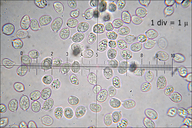|
|
click photo for larger file

Armillaria ostoyae
Honey Fungus
|
Photographer: Dr. Amadej Trnkoczy
ID: 0000 0000 0116 0703 (2016-01-05)Copyright © 2016 Dr. Amadej Trnkoczy
|
|
INFORMATION PROVIDED WITH THE PHOTO
|
date of photo Oct 6, 2010
latitude 46.33493 longitude 13.49766
View on Google Maps.
location
South slopes of Mt. Kanin mountain group west of Bovec, lower Gozdec place, next to the dirt road from Bovec to Cable car Kanin station B Čela, East Julian Alps (Posočje, Slovenia)notes Slo.: črnomekinasta mraznica - syn.: Armillariella ostoyae Romagn, Armillaria obscura (Schaeff.) Herink, Armilaria polymyces (Pers. ex Gray) Singer & Clemencon - Habitat: A widening of a dirt forest road lightly overgrown with grasses and other green plants, semi ruderal place of former forestry activities; mountain slope, south aspect; relatively warm place; locally flat, calcareous ground with a lot of half buried and buried Picea abies and Fagus sylvatica thrown away wood pieces; sunny, open place, exposed to direct rain; average precipitations ~ 3.000 mm/year, average temperature 6-7 deg C, elevation 870 m (2.850 feet), alpine phytogeographical region. Substratum: sand and gravel with buried pieces of wood; most probably on Picea abies. Comments: Not so far ago this find would be named Armillaria mellea (s.lat.) (aggregate). This group of very variable mushrooms is, based on inter-fertility tests, now divided into Armillaria borealis, Armillaria cepistipes, Armillaria gallica and Armillaria ostoyae (Ref.:1). Armillaria ostoyae is distinguished from other three species by its relatively dark colors, red-brown hut covered by dark scales, which are denser at its center, but extend just to the edge of the hut (and can be washed off by heavy rains). Also, its distinct, white, felted stipe ring resembles a cogwheel with brown tufted tips of the 'teeth' (see Picture 3. and 6.) This mushroom is a virulent parasite on live trees but continues to grow as a saprophyte on its victims, when they are dead. In my environment it is a rather common species usually found on stumps of Picea abies, often in large to very large colonies. This find shows rather old fruitbodies being unusual regarding their habitat. Several tens of mushrooms were growing virtually on sandy and stony flat surface of a dirt road side. However, closer inspection showed that the ground is full of buried wood, most probably of Picea abies. Mushrooms were growing in several dense, tufted groups of several fruit bodies; pileus diameter about 5 (7) cm; taste unpleasant, smell faint, indistinctive; SP abundant, whitish. Spores smooth. Dimensions: 7.3 [8.4 ; 8.9] 10 x 5.5 [6.2 ; 6.5] 7.2 microns; Q = 1.1 [1.3 ; 1.4] 1.6; N = 40; C = 95%; Me = 8.6 x 6.4 microns; Qe = 1.4. Motic B2-211A, NEA 100x/1.25, magnification 1.000 x, oil, in water, in vivo. AmScope MA500 digital camera. Ref.: (1) G.J. Krieglsteiner (Hrsg.), Die Grosspilze Baden-Württembergs, Band 4., Ulmer (2001), p 124. (2) S. Buczacki, Collins Fungi Guide, Collins (2012), p 190. (3) R. Phillips, Mushrooms, Macmillan (2006), p 101. (4) J. Breitenbach, F. Kraenzlin, Eds., Fungi of Switzerland, Vol.4., Verlag Mykologia (2000), p 138. (5) R.M. Daehncke, 1200 Pilze in Farbfotos, AT Verlag (2009), p 68.camera AmScope MA500
contributor's ID # Bot_465/2010_IMG2787 photo category: Fungi - fungi
|
MORE INFORMATION ABOUT THIS FUNGUS
|
| common names
Honey Fungus (photographer)
View all photos in CalPhotos of Armillaria ostoyae Check Google Images for Armillaria ostoyae |
|
The photographer's identification Armillaria ostoyae has not been reviewed. Click here to review or comment on the identification. |
|
Using this photo The thumbnail photo (128x192 pixels) on this page may be freely used for personal or academic purposes without prior permission under the Fair Use provisions of US copyright law as long as the photo is clearly credited with © 2016 Dr. Amadej Trnkoczy.
For other uses, or if you have questions, contact Dr. Amadej Trnkoczy amadej.trnkoczy[AT]siol.net. (Replace the [AT] with the @ symbol before sending an email.) |
|
|
